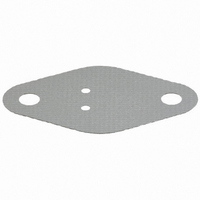SP400-0.009-00-11 Bergquist, SP400-0.009-00-11 Datasheet - Page 8

SP400-0.009-00-11
Manufacturer Part Number
SP400-0.009-00-11
Description
THERMAL PAD TO-3 .009" SP400
Manufacturer
Bergquist
Series
Sil-Pad® 400r
Specifications of SP400-0.009-00-11
Usage
TO-3, TO-66
Shape
Rhombus
Outline
33.32mm x 19.35mm
Thickness
0.009" (0.229mm)
Backing, Carrier
Fiberglass
Color
Gray
Thermal Resistivity
1.40°C/W
Thermal Conductivity
0.9 W/m-K
Lead Free Status / RoHS Status
Lead free / RoHS Compliant
Adhesive
-
Other names
7403-09FR-11
BER218
BER218
6
Selecting Dielectric Materials
Dielectric Layer
The technology of Thermal Clad resides in the dielectric layer. It is the
key element for optimizing performance in your application.The dielec-
tric is a proprietary polymer/ceramic blend that gives Thermal Clad its
excellent electrical isolation properties and low thermal impedance.
The polymer is chosen for its electrical isolation properties, ability
to resist thermal aging and high bond strengths. The ceramic filler
enhances thermal conductivity and maintains high dielectric strength.
The result is a layer of isolation which can maintain these properties
even at 0.003" (76µm) thickness. See high power lighting applications
for thinner dielectric information. This guide will help you select the
best dielectric to suit your needs for watt-density, electrical isolation
and operating temperature environment.
Standardized Methods For
Measuring Thermal Conductivity
There are several different test methods for determining a material’s
thermal conductivity value. Results can be different depending on the
method chosen, so it is important to use similar test methods in
material comparisons. See chart at right.
Standard test methods include ASTM D5470 and ASTM E1461.
ASTM D5470 is a steady state method and is referred to as the
guarded hot plate. This method provides an analytically derived value
and does not use approximations. ASTM E1461 is a transient method
referred to as Laser Flash Diffusivity. In E1461, thermal diffusivity is the
test output and thermal conductivity is calculated.
Non-Standard In-House Test Methods
The adjacent chart shows how vastly different thermal conductivity
values can be achieved by using “in-house” or non-standard test
methods. For example, when the same dielectric is chosen we can
derive a completely different and much higher thermal conductivity
value by testing a stack-up or laminate with base layer.We can modify
the test further by using different materials for the substrate to obtain
even higher results. Although thermal conductivity values are still rela-
tive to one another so a comparison can be made, these test meth-
ods do not give us an accurate depiction of true thermal perfor-
mance in the application. Included in the chart is a modeled value for
thermal conductivity, a respected model for predicting the effective
thermal conductivity of anisotropic particulate composites, but not
helpful for determining thermal performance in application. We
emphasize using standard test methods such as ASTM D5470 and
ASTM E1461, which are universally accepted and repeatable.
Note: The hot disk method is not a method we use for comparison
because typically this method measures the conductivity of the dielectric
alone, which neglects thermal interfacial resistance between layers and
carrier holding the dielectric. These values must be understood in order to
calculate the actual thermal impedance or thermal performance data.
See section regarding thermal impedance on page 7.
Thermal Conductivity
Thermal conductivity is relevant to the application’s thermal performance
when the thickness of the dielectric material, interfacial resistance and area
are taken into consideration. See “Thermal Impedance” section for more
information, as this data will be the most relevant to your application.
Method
Description
Part
Number
HT-04503
HT-07006
MP-06503
Part
Number
HT-04503
HT-07006
MP-06503
Laminate
Material
Circuit
CML
Test Methods
Model
D5470
ASTM
9.0
9.0
4.5
2.2
2.2
1.3
1 - Bruggeman Model
2 - Tested with 0.062" (1.57mm) 5052 aluminum substrate
3 - Tested with 0.062"(1.57mm) 1100 copper substrate
Standardized
1
Multi-Purpose
1
and 2 oz. (70 µ m) copper foil
and 2 oz. (70 µ m) foil
Non-Standard Thermal Conductivity Test
Hot Plate
Laminate
Guarded
MP
(W/m-K)
32.2
21.5
14.0
E1461
ASTM
Methods and Model
1.97
1.97
1.17
2
2
High Temperature
Laminate
Hot Plate
Guarded
36.4
23.3
24.0
1 - ASTM D5470
2 - ASTM E1461
Method
Description
HT
Guarded Hot Plate
Laser Flash Diffusivity
3
(W/m-K)
Laser Flash
Laminate
67.6
46.0
34.9
High Power
Lighting
2
HPL
Laser Flash
Laminate
86.5
115
102
3

























